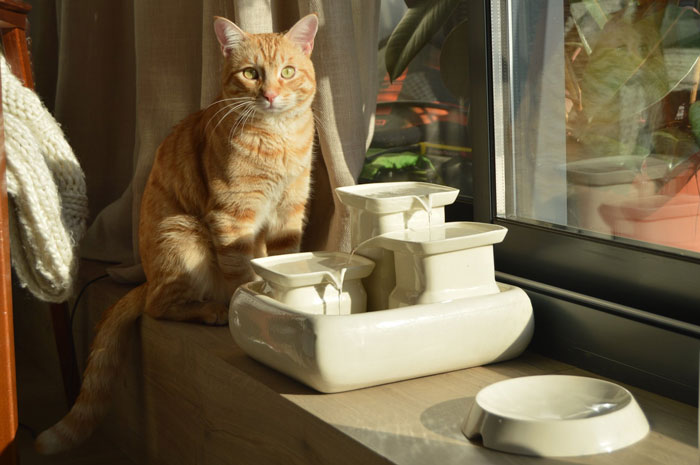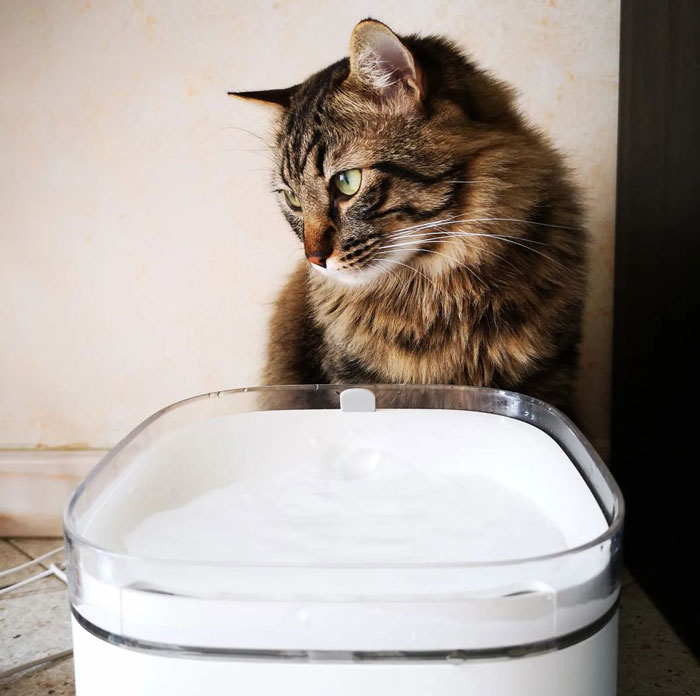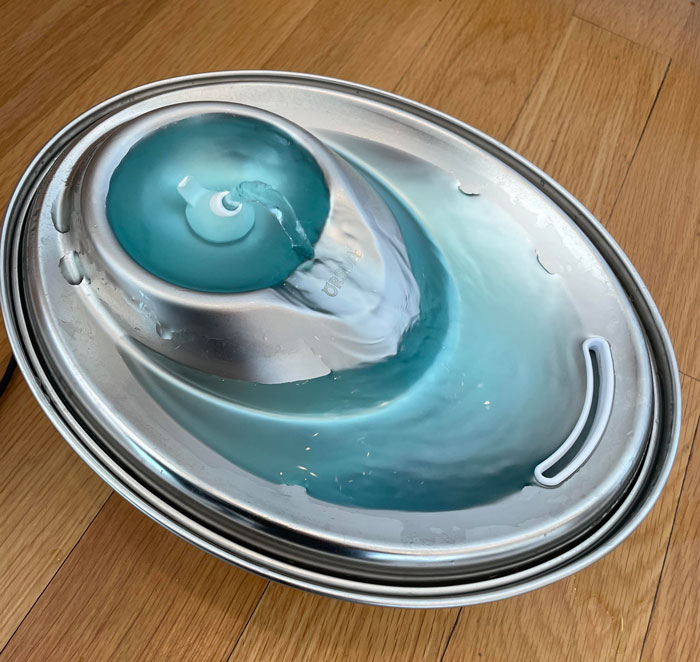Did you know that cats often prefer running water and are instinctually drawn to it as a cleaner source? Cat water fountains are a great way to encourage your kitty to drink more, but they also reduce the frequency of cleaning and refilling their water dish.
However, just like anything else, these fountains need regular cleaning to keep the water safe and healthy for your kitty. A dirty fountain causes many issues to our cat’s health, and trust me – you want to avoid that.
- Cats prefer running water, making fountains a great hydration option but require regular cleaning for health.
- Biofilm and mineral buildup in cat fountains can harbor bacteria and affect efficiency, necessitating thorough cleans.
- Daily fountain maintenance includes emptying, rinsing, and refilling; weekly steps involve deeper cleaning and disinfection.
- Vinegar can dissolve mineral deposits and biofilm safely, while diluted bleach is used for stubborn buildup or post-illness.
- Consider fountain placement and material choice for optimal hygiene, and replace filters as recommended by the manufacturer.
The information provided herein is for informational purposes only. Please refer to our disclaimer for more details..
Why Cat Water Fountains Need Special Cleaning
Cleaning a regular water bowl is easy. But fountains have extra parts, pumps, and little spaces… so why all the extra effort? Here’s why you need to prioritize regular deep cleaning:
- Biofilm: Bacteria are masters of survival and thrive in the moist environment of your cat’s fountain. Within hours, they form a slimy, invisible layer called biofilm. It’s like a miniature apartment complex for germs, offering protection and making them stubbornly difficult to eradicate. Biofilm can taint the water’s taste and potentially harbor harmful bacteria.
- Mineral Buildup: If you, like many of us, live in an area with hard water, minerals like calcium and magnesium love to make their presence known. Remember that white, crusty residue you find on your kettle or bathroom fixtures? The same buildup can occur inside your cat’s fountain, particularly on plastic surfaces.
- The Debris: Cats shed! It’s a fact of life. Fur, dust, and even the occasional food particles find their way into the fountain, providing a breeding ground for bacteria and eventually clogging the pump. This can make the fountain noisy and less efficient.
Let’s be honest – you wouldn’t drink from a glass covered in a fine layer of slime with bits of unknown matter floating around. Your cat deserves better! Regular, thorough cleaning is essential to ensure your furry companion has access to fresh and clean water sources for the best hydration.
The Essential Cleaning Toolkit
Don’t worry; you don’t need a lot of equipment to tackle this job! Even these supplies can be easily available in your home:
- Mild Dish Soap.
- White Vinegar.
- Bleach (use sparingly).
- Small Brushes (like a clean toothbrush).
- Soft Cloth.
Cleaning Your Cat Fountain – Step by Step
Cleaning your cat’s fountain may not be topping your list of favorite chores. But if you transform this into a simple, consistent routine, it can be a game-changer for your cat’s health.
Daily Maintenance
- Empty: Pour out the old water. You’ll be surprised at what might be lurking at the bottom!
- Rinse: Quickly rinse the fountain under cool water to remove any loose debris.
- Refill: Top it up with fresh, cool water. Your cat will thank you for this daily reset.
Weekly Cleaning
- Unplug: Always unplug your fountain before cleaning – just like you would with any other kitchen appliance.
- Disassemble: Take the fountain completely apart. Each model is different, so refer to your instruction manual for specifics on separating the different components.
- Wash: Give all removable parts a good scrub in warm, soapy water. Don’t neglect those small parts of the pump!
- Brushes are your friend: Those small brushes are perfect for getting into nooks, crannies, and the pump impeller (the part that makes the water flow).
- Rinse, rinse, rinse: Make sure to wipe all soap residue – cats have sensitive noses and taste buds.
Deep Cleaning (Monthly or As Needed)
1. The Vinegar Soak:
Household vinegar has mild acidic properties that help dissolve mineral deposits and tackle developing biofilm. It’s a safer alternative to bleach for routine cleaning. Here is the process:
- Prepare a 1:1 solution, one part of white vinegar, and one part water to fully submerge the affected parts.
- Let the parts soak for 30 minutes to an hour. For heavier buildup, you may need to extend the soaking time.
- Thoroughly rinse all parts with clean water to remove any lingering vinegar smell and residue.
- Follow with your regular soapy water wash.
2. Bleach Sanitization (Use with Extreme Caution):
- Use bleach only for very stubborn buildup, suspected mold, or after an illness where strong disinfection is important.
- Use a highly diluted bleach solution, typically 1 tablespoon of bleach per gallon of water. Always follow your fountain manufacturer’s specific instructions.
- Work in a well-ventilated area. Never mix bleach with other cleaning products or chemicals, especially vinegar, as this can create dangerous fumes.
- Rinse, and then rinse again! Ensure all traces of bleach and its smell are completely removed before reassembling the fountain and providing water to your pet.
Important Notes:
- Fountain Material Matters: Some plastics may be more prone to staining or retaining smells. If bleach is occasionally necessary, consider investing in a ceramic or stainless steel fountain for easier long-term maintenance.
- Prevention Pays Off: Consistent daily and weekly cleaning routines will dramatically reduce the need for deep cleaning with harsher solutions.
Tips for Optimal Fountain Hygiene
We’ve covered the cleaning basics, but a few extra considerations can make a world of difference in keeping your cat’s fountain healthy. Here are some extra insider tips:
- Location Matters: Place the fountain in a cool spot away from litter boxes and food bowls. This discourages cross-contamination and keeps the water fresher for longer.
- Material Upgrade: Plastic fountains are popular, but stainless steel is naturally more bacteria-resistant. It’s a worthwhile investment if recurring slime or odors are plaguing your current fountain.
- Filter Power: Replace those filters as recommended by the manufacturer! They don’t just deal with floating debris – charcoal filters actually help remove some impurities and improve the taste of the water. A note of caution: some charcoal filters might have loose dust, so give them a quick rinse before first use.
- Be Observant: Cats are good at hiding health issues. If your cat suddenly stops drinking as much as usual or urinates less frequently, first check the fountain for any problems (clogs, strange noises, etc.). If everything works, a trip to your veterinarian rules out any underlying medical concerns.
Frequently Asked Questions
My cat seems hesitant about the fountain. How can I encourage them?
Cats can be hesitant about new things, especially involving water. Start by placing the fountain near their usual water bowl. Run it on the lowest setting to minimize noise. You can add their favorite treat near the fountain to create a positive association. Some cats prefer room-temperature water, so start with slightly less cold water than usual.
Is distilled water better for cat water fountains?
While distilled water removes all minerals, it can make the water taste a bit flat for cats. In most cases, tap water filtered through the fountain’s filter is perfectly safe. If you have very hard water with noticeable buildup, a mix of filtered tap water and distilled water could be a good compromise to reduce mineral deposits without affecting the taste too much.
Should I use bottled water in my cat’s fountain?
It depends on the quality of your tap water. If your tap water is safe for you, it’s usually safe for your cat, especially when used with the fountain’s filter. Bottled water can be a good option if you’re concerned about contaminants in your tap water, but it can get costly over time. Remember, change the fountain water daily, even with bottled water, to prevent bacteria buildup.
How often should I change the fountain filter?
Always follow the fountain manufacturer’s recommendations, as the lifespan of filters can vary. Generally, filters should be changed every 2-4 weeks to keep the water fountain clean. More frequent filter changes might be necessary if you have several cats or cats that shed a lot.
My fountain keeps getting noisy. What should I do?
A noisy fountain usually has two causes: low water levels or a dirty pump. First, make sure the fountain reservoir is filled to the recommended level. If it’s still noisy, it’s time for a pump cleaning. Carefully disassemble the pump and clean any debris that might be obstructing the impeller (the spinning part). Consult your fountain’s manual for specific instructions.
123views
Share on Facebook
 Image credits:
Image credits:  Image credits:
Image credits:  Image credits:
Image credits: 


2
0